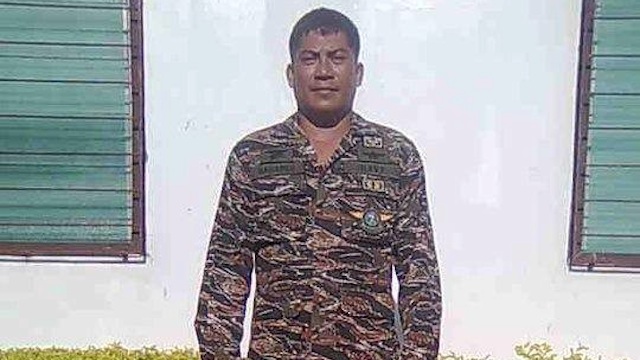
FIRST CASUALTY: Navy Petty Officer Jose Audrey Bañares of the elite Naval Special Operations Group (NAVSOG). Photo courtesy of the Philippine Navy
He was with the elite unit that first clashed with rebels off the waters of
Navy Petty Officer Jose Audrey Bañares of the elite Naval Special Operations Group (NAVSOG) was deployed to guard the coast of
Bañares was among the best, one of only 400 members of the Philippine Navy trained to conduct what the millitary would call maritime interdiction — the ability to destroy or stop enemy forces en route to the battle area. He's the equivalent of a US Navy Seal. (The Philippine Navy has a total of 20,000 troops.)
Sometimes it’s the Abu Sayyaf that the NAVSOG is after. That day it was a faction of the Moro National Liberation Front (MNLF) that, according to intelligence reports, was going to attack the city.
Bañares and his unit spotted the rebels at 1:45 am on September 9 between the waters of Basilan and
Six other soldiers were wounded. Seven MNLF were reportedly killed although their bodies were not recovered.
“We are the first to respond and we are the last to leave. It is our operational doctrine,” said navy spokesperson Commander Gregory Fabic. Bañares was one of 2 NAVSOG killed in Zamboanga.
JSOG: Command and control
At sunrise on September 9, the rebels marched towards the city hall to hoist their flag and symbolically declare their independence. They forced residents to join them, took them as hostages, and shot those who tried to resist, according to various accounts.
In Barangay Sta Barbara, they were blocked by government troops. Thus began the standoff that shut down the city for 3 weeks.
READ: Bungled chances in Zamboanga City
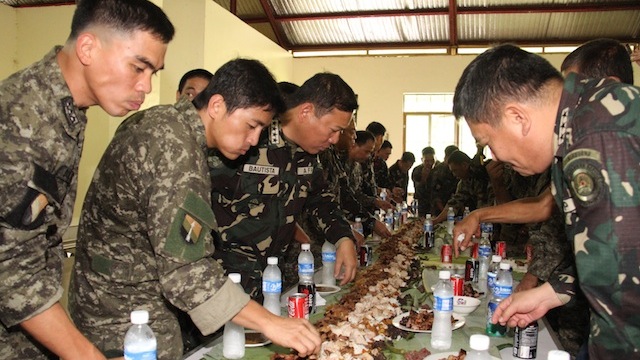
BOODLE FIGHT: Armed Forces Chief Gen Emmanuel Bautista joins operating troops of the Joint Special Operations Group (JSOG) in a boodle fight. JSOG took the lead role in the standoff in
The crisis that lasted 20 days required the full might of the Armed Forces of the Philippines (AFP). Over 3,000 combined forces of the navy, air force, and army worked together to fight a unique war in an urban, populated terrain, a battlefield they're not used to in western
In the end, the siege killed 24 government troops — 19 from the military, 5 from the police — and wounded 183. On the part of the MNLF, government data show a total of 183 killed.
At sea, the navy set up a blockade to prevent other rebels from reinforcing the MNLF units already in the city, and to stop the attackers from leaving. On the ground, the army tried to contain the gunmen in 5 barangays and eventually cornered them along the boundary of Sta Barbara and Sta Catalina where the MNLF remnants made their last stand.
The Joint Special Operations Group (JSOG) led the assault against the MNLF in
But the last to leave the combat zone were the Philippine Marines. They played a key role in the 2000 government takeover of
In
Air Force: Strikes, rapid deployment
The air force first dispatched its Huey combat utility helicopters and the MG-520 light attack helicopters for reconnaissance flights, tactical lifts to bring troops to the combat zone, and persuasion flights.
When the rebels showed equal tenacity in the first 24 hours of the siege, the military was forced to bring in more troops and supplies from other areas through the C-130s.
The air force now has 3 working C-130 cargo planes that are used to bring in troops and military hardware. If the siege happened a year ago, the air force would have had to live with only one operational C-130.
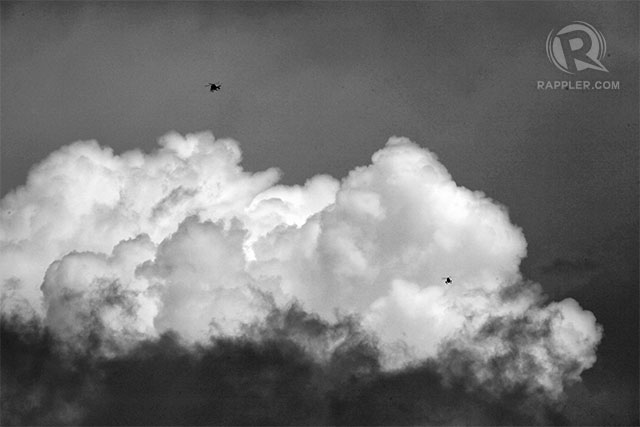
AIR BOMB: 2 MG520 choppers drop bombs in a fishpond at Barangay Rio Hondo, where suspected MNLF leader Habier Malik was reportedly hiding. Photo by LeAnne Jazul/Rappler
The pilots worked double time. On Day 2 of the crisis, September 10, President Benigno Aquino III declared an "overwhelming force" in
During the early days of the siege, only the air force's planes and helicopters could fly into Zamboanga. Flight paths were changed to make sure the planes didn't fly over the combat zone. They couldn't risk the rebels shooting them down.
The risk was real. Choppers securing the President's plane were shot at when he flew into Zamboanga, Interior and Local Government Secretary Manuel “Mar” Roxas II said in one of his press conferences during the crisis.
While rapid deployment was the most crucial role of the air force, the pilots also provided close air support and joined the gunfight. The 14th Strike Wing was responsible for the air strikes.
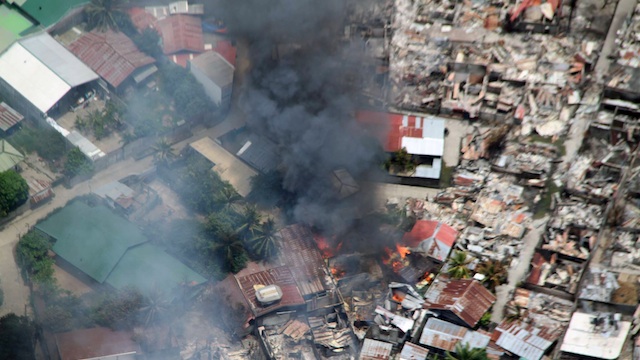
BURNED HOUSES: In the end, over 10,000 houses were damaged inside the
Army’s Light Reaction Battalion
On the ground, the terrain proved tough for battle-tested troops used to fighting rebels in the jungles and remote, uphill areas.
The villages occupied by MNLF rebels were populated with thousands of residents who live in shanties, own small shops and work in buildings. The rebels were shooting from rooftops, windows and back alleys. Their biggest defense were the residents trapped in the battle zone.
It was a conflict that required the kills of the Light Reaction Battalion (LRB), the army’s lead counter-terrorist unit composed of Scout Rangers and Special Forces. As the name connotes, they move with speed and carry only the most essential weapons with them.
Trained by the Americans after the September 11, 2001 attacks, the unit started as a Light Reaction Company of two dozen troops. They are trained to clear buildings. They are experts in counter-sniper tactics. They can fight in total darkness using modern gadgets and equipment. About 300 of them were deployed to
“The terrain requires different approaches. There are a lot of places to hide. There are many alleys and many walls. You don’t even know that your enemy is on the other side of the fence,” explained AFP spokesperson Lt Col Ramon Zagala, who himself belongs to the Philippine Army's Special Forces.
The LRB troops got the honor of finishing the fight but also the tragedy of losing the most — 12 of them.
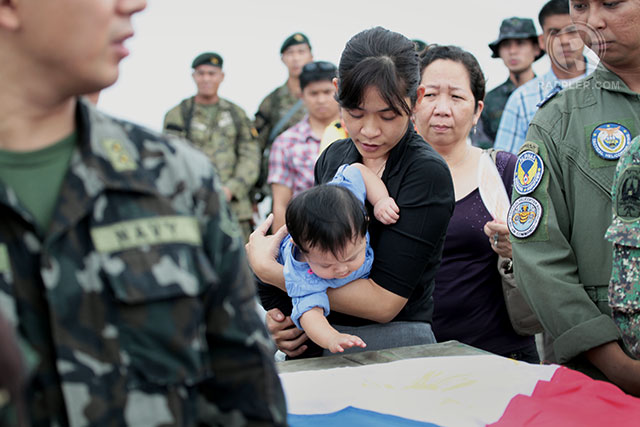
FALLEN SOLDIER: The widow and child of 1Lt Francis Damian. Photo by LeAnne Jazul/Rappler
Army Scout Ranger 1Lt Francis Damian was one of the officers killed during the operation against the MNLF. A sniper bullet pierced through his helmet, damaging his skull. He was brought to the hospital but died later.
The MNLF snipers, who were able to take strategic positions inside the combat zone, delayed military operations and claimed many soldiers' lives.
That and the burning, Zagala said. Fires repeatedly forced the soldiers to retreat. Over 10,000 houses were damaged, according to government data.
Despite the cost and the loss, the military maintained it's mission accomplished for them.
“In the history of the AFP, this is among our greatest achievements as a military institution,” Armed Forces chief of staff Gen Emmanuel Bautista told reporters.
His father, the late Brig Gen Teodulfo Bautista, was killed in 1977 by MNLF members when he chose to meet with them — unarmed — in Patikul, Sulu to discuss a possible ceasefire.
"Personally, I did not allow that to cloud my decisions, and I did not want to be at the forefront [during the operations]. If you noticed, I was very low key." It's his father's 36th death anniversary on October 10.
On Day 19 of the crisis, September 27, all hostages were accounted for. According to military statistics, 195 hostages were rescued, two were killed, and 7 were wounded.
"By any standards, I think that is a good accomplishment on the part of the military," Bautista said.
The thousands of Zamboangueños uprooted from their homes and now crammed in evacuation centers in the city would probaby disagree.
http://www.rappler.com/nation/40831-navy-elite-zamboanga-city-crisis

No comments:
Post a Comment
Note: Only a member of this blog may post a comment.